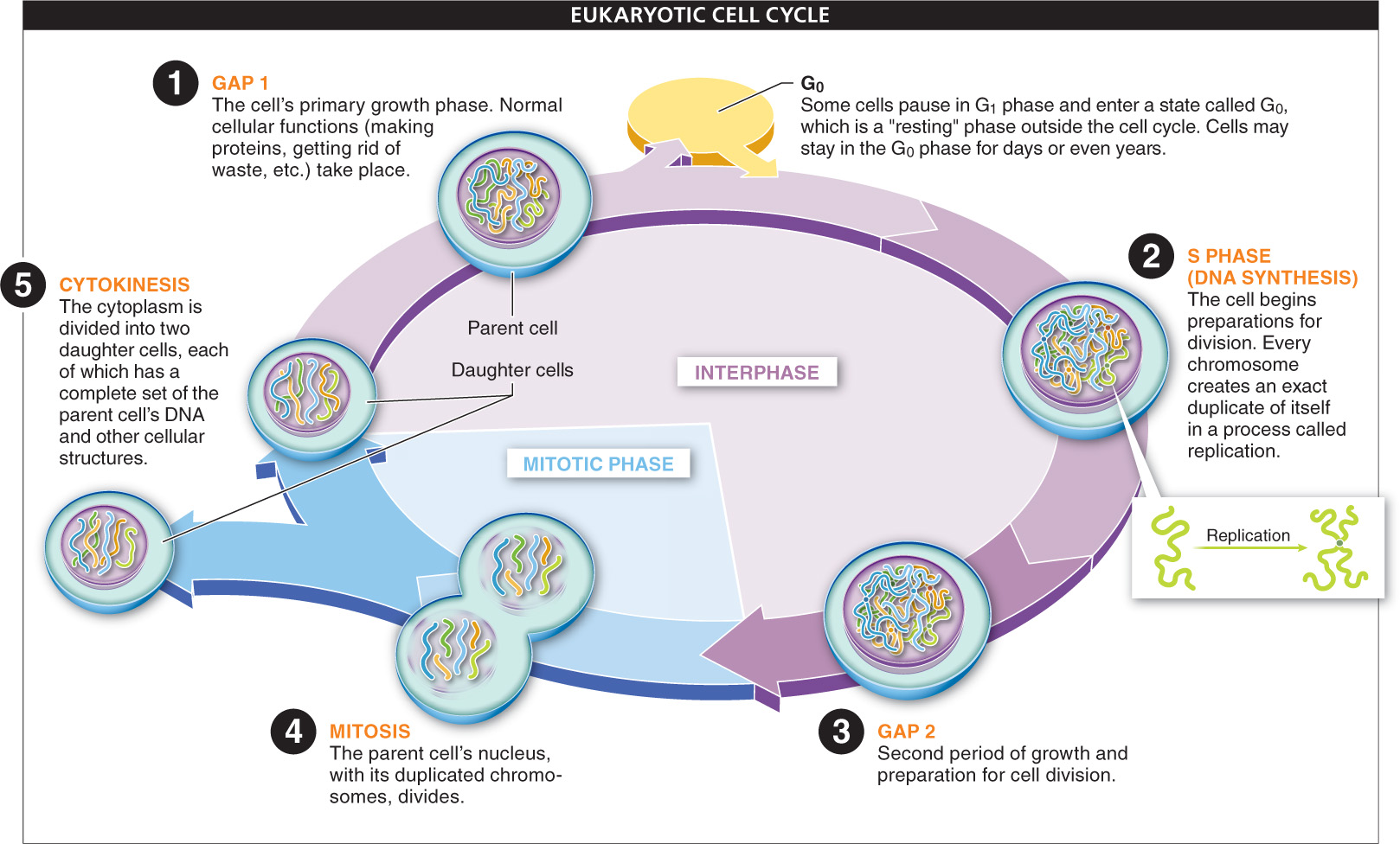In life, we often go through phases that are defined by the primary focus of our interests and activities. For many years we go to school. For a while we may tend to our career. Then, for a spell, our personal life may take center stage. Most eukaryotic cells go through phases, too. They spend long periods of time occupied with activities relating solely to their growth, and then may suspend those activities as they segue into a period devoted exclusively to reproducing themselves. This alternation of activities between processes related to growth and processes related to cell division is called the cell cycle (FIGURE 6-5).

Before we go any farther in discussing the cell cycle, we need to note an important distinction among the cells of the body. All the cells of a multicellular eukaryotic organism can be divided into two types: somatic cells are the cells forming the body of the organism; reproductive cells are the sex cells—
Somatic cells and reproductive cells use different methods of producing new cells. In this section, we focus on cell division as it occurs in somatic cells. Later in the chapter, we examine cell division that leads to the production of sex cells.
The cell cycle describes the series of phases in somatic cell division. There are two main phases in the cell cycle: interphase, during which the cell grows and prepares to divide, and the mitotic phase (or M phase), during which first the nucleus and genetic material within the cell divide, then the rest of the cellular contents divide. Interphase is further divided into three distinct sub-
7
Interphase The three sub-
Gap 1 (G1). During this period, a cell may grow and develop as well as performing its various cellular functions (making proteins, getting rid of waste, and so on). Most cells spend most of their time in the Gap 1 phase. Some cells pause in the Gap 1 phase and enter a state called G0, which is a quiescent or “resting” phase outside the cell cycle in which no cell division occurs. Cells may stay in the G0 phase for days or even years—
DNA synthesis (S phase). During this phase, the cell begins to prepare for cell division, first by creating an exact duplicate of each chromosome by replication. Before replication, each chromosome’s DNA consists of a single long, linear molecule. After replication, each chromosome’s DNA has become a pair of identical long, linear pieces, held together near the center; the region where the two pieces are in contact is called the centromere. (As we’ll see, the centromere also serves as the point to which spindle fibers can attach.)
Gap 2 (G2). This phase, which is generally much shorter than Gap 1, is usually characterized by significant growth, as well as high rates of protein synthesis in preparation for division. This phase differs from Gap 1, though, because the genetic material has now been duplicated.
Mitotic Phase This period begins with mitosis, a process in which the parent cell’s nucleus, including its chromosomes, divides. Mitosis is generally followed by cytokinesis (which may begin prior to the end of mitosis), during which the cytoplasm is divided into two daughter cells, each of which has a complete set of the parent cell’s DNA and other cellular structures. The mitotic phase is usually the shortest period in the eukaryotic cell cycle.
The cell cycle describes the series of phases in somatic cell division, but it’s not a one-
Variation in the rates of cell division is regulated by a cell-
The signals that trigger transitions to subsequent phases in the cell cycle most commonly consist of growth factors, which provide feedback about the cell’s environment and can signal that division is appropriate.
There are three primary checkpoints that regulate the cell cycle in eukaryotes (FIGURE 6-6).

1. G1/S checkpoint: assessing DNA damage and cell growth. Occurring near the end of the G1 phase, this is the point when a cell “decides” whether it will proceed to the S phase and complete cell division, or delay cell division, or enter into an extended “resting” phase, G0.
8
Although often described as an extended “resting” phase, G0 is not actually a time of rest for a cell; in fact, it may be characterized by great metabolic activity that is critical to an organism’s proper functioning. Rather, G0 is simply a non-
Several situations can prevent a cell from passing this G1/S restriction point. Cells cultured in the lab, for example, will delay division at this point if the medium in which they are grown does not contain sufficient nutrients. If a cell’s DNA has been damaged, too, the cell may be blocked from entering the S phase (and DNA repair mechanisms may be triggered). A malfunction in the G1/S checkpoint can prevent cells with damaged DNA from blocking cell division, leading to uncontrolled cell division and cancer.
2. G2/M checkpoint: assessing DNA synthesis. Just before beginning mitosis, a cell reaches the G2/M checkpoint. This checkpoint serves as a “mitosis-
3. Spindle assembly checkpoint: assessing anaphase readiness during mitosis. This important cell-
TAKE-HOME MESSAGE 6.3
Eukaryotic somatic cells alternate in a cycle between cell division and other cell activities. The cell division portion of the cycle is called the mitotic phase. The remainder of the cell cycle, called interphase, consists of two gap phases (during which cell growth and other metabolic activities occur) separated by a DNA synthesis phase, during which the genetic material is replicated. A cell-
What are mitosis and cytokinesis, and how are these two processes related?
The division of a cell involves both mitosis and cytokinesis. Mitosis is a process in which the nucleus of the parent cell duplicates, while cytokinesis is a process during which the remainder of the cell duplicates.